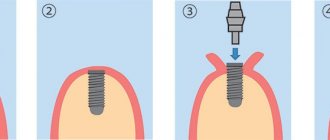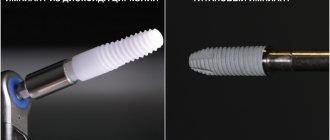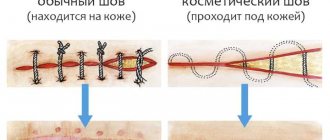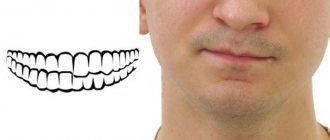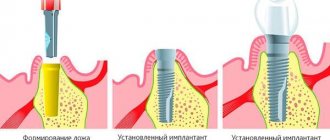When are templates needed for dental implantation?
Aligners are mainly used in difficult cases - when a nerve or vessel passes near the site of the intended installation of a titanium pin. The template is also needed when:
- large volumes of implantation, when several implants are implanted simultaneously;
- absence of teeth that cannot serve as a guide for implantation;
- replacement of anterior teeth, the restoration of which requires special aesthetics;
- the presence of bone tumors and consequences of jaw injuries;
- complex bone anatomy, tissue atrophy and implantation of zygomatic implants;
- implantation of implants at an angle for extended defects, edentia.
Surgical mouthguards are a technology that significantly improves prognosis.
What you need to know about the profession
First, let's look at who an implantologist is, what his responsibilities are and what he should be able to do.
A doctor’s services are sought when it is necessary to completely or partially restore teeth in the upper or lower jaw. At the same time, only advanced modern technologies and environmentally friendly materials will be used.
It is for this reason that the doctor is required to have knowledge of methods and the ability to use implant materials and equipment.
Preparation before creating surgical guides
The production of stencil templates is carried out after examination of the oral cavity, computed tomography and 3D modeling. A set of measures allows you to plan implantation and decide exactly where and how the implants will be installed.
CT is performed using a dental tomograph, which takes images layer by layer and combines them into a single three-dimensional model. It visualizes the topography of the most important structures: the maxillary sinus, the mandibular nerve and blood vessels.
Computed tomogram:
- Allows you to see impacted teeth.
- Provides information about the condition of bone tissue.
- Helps plan the stages of the operation.
A virtual implantation program operates based on tomography. Special software “tryes on” different types of implants and types of their placement to the patient’s jaw. The result of 3D planning is:
- positioning;
- selection of tools;
- creating an operation plan.
Based on these data, a navigational surgical template is created.
Competence and Responsibilities
An implantologist specializes in the complete restoration of lost teeth.
Innovative technologies allow specialists to install titanium analogues of tooth roots into bone tissue. It is impossible to distinguish the system from anatomical roots.
The doctor conducts a full examination, preparation in several stages and implantation surgery. Observes the patient throughout the entire period of rehabilitation after the intervention.
To carry out his activities, the doctor must:
- Higher medical education in dentistry with a specialization in surgery. After all, the manipulations performed by a doctor refer to surgical intervention.
- Qualification in implantology. To work in a sought-after field, you need knowledge about implantation and bone tissue transplantation.
- Prosthetics skills. Installation and selection of prostheses.
Getting a medical education is only part of success; a doctor’s responsibilities include:
- Working with fears. Patients come with serious problems, the solution of which directly affects the quality of life. The implantologist must be able to communicate with people, calm them down and aim for a successful outcome of the event.
- Consultation. Identify problems and optimal solutions.
- Identification of contraindications. Installing an implant is a serious surgical procedure that requires a full assessment of the patient’s health.
- Drawing up a treatment plan. Structure the stages of treatment and select activities in each case. For each case, a plan is drawn up individually.
- Carrying out treatment. This includes the installation of an implant, the healing period, and the installation of a prosthesis or crown.
- Observation. After successful completion of treatment, the doctor monitors the patient’s condition for at least six months.
A dentist-implantologist must love his profession and have a great desire to help patients.
Nowadays, implantology is one of the most popular areas in dental prosthetics, and the presence of demand should not affect the quality of work or attitude towards people in order to make a profit.
The doctor must first of all fulfill his direct function - to help solve problems!
Indications for installing a removable denture on mini-implants, the pros and cons of the designs.
Come here if you are interested in the price of All on 4 implantation.
At this address https://www.vash-dentist.ru/implantatsiya/metodiki/chto-takoe-transfer-chek.html read about the purpose of a transfer check in dentistry.
How are implant templates made?
Templates are created automatically using special 3D printers. This is another new technology that has found application in dentistry. To create a template, the data obtained from 3D planning is digitally transferred to a printing machine, and an acrylic tray is produced.
The printer creates it in full accordance with the given program - without errors or deviations from the plan. This allows you to avoid the notorious “human factor” associated with insufficient experience or mistakes of the dental technician.
So, what are the advantages of the ImplantGuide technology?
- Full mutual understanding between the orthopedist, surgeon, and dental technician in choosing the best design, the ability to involve other specialists before and at the stage of implantological treatment;
- Optimal placement of the implant as a support for the future orthopedic structure;
- Selection of the optimal individual operating technique in each clinical case;
- Precise positioning of the implant in the planned location;
- 2-5 times reduction in the time of dental implantation surgery;
- Minimal trauma, pain and swelling after surgery, reducing the likelihood of dental complications;
- 100% predictable and guaranteed final aesthetic result;
- Possibility of installing implants without incisions (bloodless implantation method);
- Allows you to perform precise and safe operations.
Why do dentists need a template when implanting teeth?
As a rule, templates are used for express dental implantation. This operation is performed through the gums, without incisions or stitches. When installing implants, the doctor does not see the bone, which can lead to incorrect positioning of the implant in the jaw.
Having a template for implantation allows doctors to:
- avoid mistakes and complications;
- ensure the quality and accuracy of the procedure;
- correctly align the axes of several implants;
- select positioning and implantation depth;
- it is more convenient to drill into the bone, without slipping off the sharp ridge;
- accurately implement the virtual implantation plan;
- simulate the orthopedic stage, its features and results;
- make temporary crowns using a printer or manually.
Start treatment at NovaDent
NovaDent is the perfect balance between professional medical care according to European quality standards and a comfortable price. “Best professional implantation” according to the National Council of Medicine - NovaDent deservedly holds the position of leader in the field of dental implantation in Moscow.
Sign up for a consultation right now and receive three treatment plans and a consultation with the clinic’s chief physician as a gift.
Why do we need a template when implanting teeth into patients?
Using a template guarantees that the predicted result will be achieved. This is a major plus for the patient. This is especially true if you have an incorrect bite, large amounts of work, or other problems.
Surgical navigation template:
- allows you to get the planned result;
- accelerates rehabilitation and implantation;
- reduces the time, invasiveness and traumatism of the operation;
- allows the use of shorter anesthesia, which is especially useful for patients with cardiovascular pathology;
- helps prevent complications in the postoperative period;
- visualizes what each stage of treatment and its result will look like when planning.
The doctor plans the length of the “span” and the design features of the bridge, selects the type and direction of implantation in order to achieve aesthetic and functional rehabilitation.
The template allows you to turn your plans into reality, extending the service life and ease of use of prostheses.
Brief job description
Surgery is hard work, involving psychological and physical stress. The job description regulates the activities of the employee, limiting and establishing his responsibilities and rights. Main provisions of the document:
- higher education, appropriate level of training;
- knowledge of current regulations and other legislative documents of the Russian Federation;
- mastery of methods, means, and sequence of medical care;
- theoretical knowledge, possession of practical skills in this area;
- organization, structure, tasks, equipment of the dental surgical service;
- compliance with internal labor regulations;
- monitoring the actions of support staff;
- responsibility for the effectiveness of treatment.
Stages of making a template
Imprint
. Using an impression tray, for example from A-silicone, an impression is made of the entire dentition. It is scanned or a plaster model is made, which is then scanned. Based on the impression, a computer model of the target jaw is created.
CT
. Provides data for 3D modeling. Before scanning, it is necessary to remove all removable structures and open the teeth. Both dentitions are visualized.
Depending on the type of defect, an impression tray can be used for diagnosis (distal defects, fixed x-ray transparent bridges). The finished result is a DICOM file with a large number of frames.
3D modeling
. The DICOM file or set of single-frame images is processed by the software. Selected:
- tools and drilling modes;
- types of implants and their positioning.
Printing the template
. The template modeled on a PC is transferred to a 3D printer for printing. Printing is carried out using polymer materials.
A little bit of history
Tooth loss has occurred in people at all times. The first attempts to restore implants were noted in ancient times.
The initial goal of such procedures was to restore the functional abilities of the jaws. The first artificial teeth were inserted only during meals, because... were practically not fixed on the jaw.
To carry out procedures, people used improvised means - wood, metal, teeth of animals and other people.
In the 19th century, the first intraosseous implants appeared, which served as the basis for modern products.
The concept of an implantologist appeared only at the beginning of the last century. Today, this branch of dentistry is very developed and has a wide range of artificial implants that are highly aesthetic.
How much does it cost to make navigational surgical templates?
The cost of the template depends on the material, manufacturing technology used and the number of guides. The minimum price for making a template starts from 6 thousand rubles.
3D implantation modeling allows you to plan the entire treatment process on a computer and install implants in an absolutely precise position, taking into account future crowns. When creating them, all the specialists on whom the success of implantation depends: an implantologist, an orthopedist and a dental technician participate. The result of coordinated work is the patient’s perfect smile!
Price
| Implantation system | AnyOne | AnyRidge | Astra Tech |
| A country | South Korea | South Korea | Sweden |
| Class | Economy | Standard | Premium |
| Implant material | Titanium Grade 4 | Titanium Grade 4 | Titanium Grade 4 |
| Implant warranty | for life | for life | for life |
| Implantation guarantee | |||
| Price | 16,500 rub. | 25,000 rub. | 64,250 rub. |
| Possibility of installation in installments | 0% | 0% | 0% |
| Implantation system | Osstem | Implantium | Nobel |
| A country | South Korea | South Korea | Sweden |
| Class | Economy | Standard | Premium |
| Implant material | Titanium Grade 4 | Titanium Grade 4 | Titanium Grade 4 |
| Implant warranty | for life | for life | for life |
| Implantation guarantee | |||
| Price | RUB 30,400 19,500 rub. | 25,000 rub. | 64,250 rub. |
| Possibility of installation in installments | 0% | 0% | 0% |
Osstem implants
(South Korea)
25,000 rub.
19,500 rub.
More details
| Implantation system | Osstem |
| A country | South Korea |
| Class | Standard |
| Implant material | Titanium Grade 4 |
| Implant warranty | for life |
| Implantation guarantee | |
| Price | 25,000 rub. 19,500 rub. |
| Possibility of installation in installments | 0% |
Implantium implants
(South Korea)
25,000 rub.
More details
| Implantation system | Implantium |
| A country | South Korea |
| Class | Standard |
| Implant material | Titanium Grade 4 |
| Implant warranty | for life |
| Implantation guarantee | |
| Price | 25,000 rub. |
| Possibility of installation in installments | 0% |
Astra Tech implants
(Sweden)
55,000 rub.
More details
| Implantation system | Astra Tech |
| A country | Sweden |
| Class | Premium |
| Implant material | Titanium Grade 4 |
| Implant warranty | for life |
| Implantation guarantee | |
| Price | 55,000 rub. |
| Possibility of installation in installments | 0% |
Nobel implants
Sweden
55,000 rub.
More details
| Implantation system | Nobel |
| A country | Sweden |
| Class | Premium |
| Implant material | Titanium Grade 4 |
| Implant warranty | for life |
| Implantation guarantee | |
| Price | 55,000 rub. |
| Possibility of installation in installments | 0% |
Expert of the article you are reading: Zakharkin Maxim Borisovich Implantologist, orthopedist, dental surgeon, leading specialist of the NovaDent network
17 years
Clinical experience
Skhodnenskaya
Khimki Boulevard, 14, bldg. 2
+7
Free consultation with this specialist
Reason to contact a specialist
A consultation with an implantologist is usually prescribed by other specialists - a therapist, surgeon or orthodontist. In rare cases, patients independently make an appointment with this doctor.
Despite the active development of this area of dentistry, people resort to the services of an implantologist only in extreme cases.
The reason for contacting a specialist is the need to restore one or more teeth using implants.
An implantologist corrects the following defects:
- Loss of a tooth in any part of the mouth;
- Loss of several units of dentition;
- The absence of units that could become supporting when fixing the bridge;
- Adentia (complete absence of teeth);
- Inability to install a removable denture (allergies, gag reflex, intolerance to components);
- Development of bone tissue atrophy in the crest area, making it impossible to use removable dentures;
- Patient's reluctance to wear removable structures;
- Functional occlusion (pain when closing).
Implantation in these cases is possible only in the absence of direct contraindications:
- Anemia and blood diseases;
- Diabetes;
- Hypertension and heart failure;
- Oncological pathologies;
- Immune diseases;
- Infections;
- Mental disorders.
Is it really possible to carry out dental implantation for hepatitis, and what methods are used?
Visit here to learn more about Harvest Smartprep technology for dental implants.
We will tell you about this address https://zubovv.ru/implantatsiya/metodiki/populyarnyie-alternativyi.html what an alternative to dental implantation exists.
